Mike Vardy's Blog, page 70
July 11, 2016
The Productivityist Podcast: Avrum Nadigel
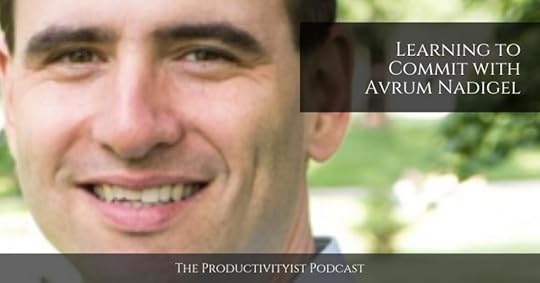
On this episode of the podcast I chat with Avrum Nadigel. He is an author and relationship therapist. He co-produces “It’s the anxiety, stupid!” – a podcast about relationship angst, and draws a comic about intimacy called “Ball and Change”. His new book, Learning to Commit (The Workbook): Becoming Your Best Self to Find Your Best Match, will be published by Self-Counsel Press in November 2016.
We talk about his move away from GTD (Getting Things Done) and back to a higher level of thinking and workflow (a la Stephen Covey), the things that drive him nuts that productivity authors and users, and dive into his biggest fear.
Relevant Links
Avrum Nadigel | Official Websitehttp://www.nadigel.com/
Why I’ve Left GTD Behind: Part One | Productivityis
Why I’ve Left GTD Behind: Part Two | Productivityist
Why I’ve Left GTD Behind: Part Three | Productivityist
Stephen Covey’s 7 Habits
The 8th Habit by Stephen Covey
Getting Things Done | Official Website
Back to Work 261: The Illusion of Ease
The Covey Community
Daylite by Marketcircle
WISHCRAFT by Barbara Sher
Autofocus: a closer look at “dismissal” | Mark Forster
What is a “no list” system? | Mark Forster
Deep Work | Cal Newport
The Human Search for Meaning | Farnam Street
Learning to Commit
Avrum Nadigel on Twitter
If you enjoy The Productivityist Podcast I’d appreciate a rating and review in iTunes or your podcasting platform of choice. It helps people find the show easier and will help me make improvements on the show by seeing what you have to say. You can also fill out this survey to help me make the show better.
Want to help the show even more? Then become a patron The Productivityist Podcast through our Patreon campaign! Check out The Productivityist Podcast’s Patreon page and take a look at all of the perks – available only to Patreon supporters!
The post The Productivityist Podcast: Avrum Nadigel appeared first on Productivityist.
July 7, 2016
Using Gaming To Be Productive
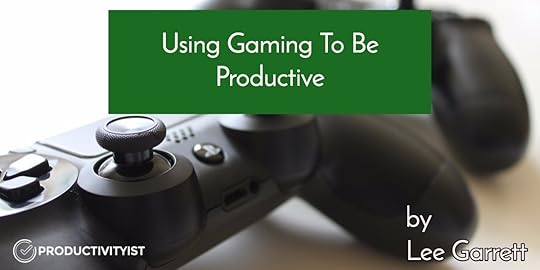
Do you feel guilty when you take the time to do something just for you? It could be sitting down in front of Netflix. Maybe you love to disappear into the ether of social media with Facebook or Twitter. Many people love to sit back when there is a football (also known as soccer for my transatlantic chums) match on and forget about real life. I certainly fit into that category.
Yet why do we feel that guilt for taking a break? More importantly, how can we rid ourselves of that horrible feeling?
Let me tell you how I dealt with this issue myself.
I should say at the outset that as much as I’ve tried to fight it over the years, I can no longer hide the truth. I need to accept and embrace it as a core part of my life.
I’m a gamer.
There – it’s out there. That genie isn’t going back into the bottle anytime soon.
For the past eighteen months, I’ve devoted myself almost completely to my work and family. Nearly every waking hour has been spent driving myself forward. I’ve been studying, growing, loving and caring for those I hold most dear. Yet through all of this, something was left neglected. A part of me that existed for the previous thirty years was no more.
That deep yearning to play soccer like a pro, attack like a ninja and build constructions like an extra in The Lego Movie lay dormant.
Fortunately, my wife knows me better than anyone on this planet. So, on Christmas morning, I was the lucky recipient of an Xbox One. Best of all, the console came with the latest version of my favourite gaming franchise of all time, Fallout 4.
Inside I leapt for joy. Yet, at the same time, I felt horribly conflicted. As a productivity nut, I just found myself asking, “Where am I going to find the time to enjoy this?”
For the first two days, the Xbox sat in its box whilst I enjoyed spending quality time with my children, sharing their joy and living intentionally in the moment. All of these are things that can be very scarce when you lead the lifestyle I do. Then, on the 27th, I set it up and sat down to enjoy my gift. However, I found myself plagued with guilt. Not because I’d just learned how to decapitate someone virtually with a modified tire iron. No, this was because I kept asking myself the same question.
“What else should I be doing right now?”
That’s a horrible state to be in. I’m sure many of you reading this right now have been in the same position. For those that haven’t, just imagine being so used to living for others and being so busy that you feel guilt every time you take time out for yourself. That’s no way to live and fortunately, I was quick to realize this.
I needed to find a way of eradicating that guilt. I had to develop a system that would allow me to enjoy this down-time and know that this is what I should be doing now, without sitting in my own judgement.
That’s when my Apple Watch did it’s 8pm jig on my wrist and I had that eureka moment. (Those pop up in my head every so often.)
Streaks is my current habit tracker of choice. Every evening the app would alerting me to the fact that three of the habits I had set were still waiting on me to clear them for the day. One of these I could readily explain, owing to the fact that I was on my holidays and watching my daily Lynda.com video simply wasn’t the appropriate use of my time.
However, I had two other habits that were difficult to integrate. One was an increased step count for the day. For some reason, I continually fell short on that goal. The last goal was to conduct a daily review of my journal entries. This something that would benefit me in the long term, yet for whatever reason, I just couldn’t get it into my daily routine.
Remember, just because we write about productivity, that doesn’t make us infallible. We are all humans after all.
I also was struggling with my wake-up time. I found myself using the snooze button more than ever. Something needed to change.
Then I came up with an idea.
What if I rewarded myself for the successful completion of these habits (or rituals) with dedicated gaming time? Then, when I sat down to play, I would feel as though it was something that I had earned.
So this is exactly what I did. I now have four habits/rituals that are set in Streaks every single day. Every time one of these is achieved, I earn fifteen minutes in my Xbox ‘bank’. Now, there is never more than an hour spent a day enjoying this little luxury of mine. When the habit has formed (which from experience will be around thirty days) then I moved it away from Streaks and replaced one habit with another.
In order to help decide on which action to replace it with, I review my quarterly goals and see where I need help. If all seems to be fine, I look at a higher level at the hats I wear. How can I improve as a father? A husband? A businessman? A student? A home owner? I look for habits that will help fulfill my goals and push me to be the best version of myself I can.
I’ve always functioned best when I know that I’m going to be rewarded with something. I used to feel guilty about this, but not any longer. I know there are many other people just like me out there, which is why I feel great about writing this post.
Using my Xbox bank means that now I can partake in virtual gratuitous violence without feeling a twinge of guilt.
What a way to live.
You too can take the guilt away from your own ‘guilty’ pleasures by treating them as rewards. The fourth season of House of Cards is out on Netflix soon. Wouldn’t it be great if you could start working towards this treat now so you can binge-watch and not feel bad at all?
I can’t think of a better way to work towards being the best version of myself.
The post Using Gaming To Be Productive appeared first on Productivityist.
July 5, 2016
Step Away from the App
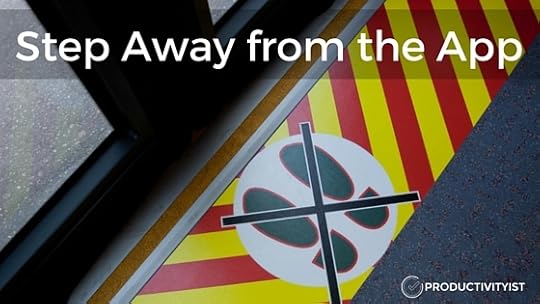
When people ask me “What app should I use to help me be more productive?”
I have a simple answer. “I don’t know.”
They will look at me quizzically and remind me that I’m someone that should know what app they should use. “You’re the expert,” they’ll say.
But here’s the thing. Everyone’s work style is different. Everyone’s proficiency with apps is different. Everyone’s needs are different.
So in order to even begin to recommend an app, I need to know more about the person asking the question.
Sometimes a simple to-do list app will do the trick. Sometimes a habit tracking app is enough because they tend to trust their paper-based workflow for their tasks. Sometimes a paper planner is the “app” they will be able to use best.
I can’t possibly suggest what app they use until they give me more to go on. And even then, I’ll exercise caution.
The only time I’ll really suggest a radical change is when the person is using email to manage their tasks (and even then I need to look at a solution that will work best for them as they shift on that front) or when they use a calendar to manage their tasks (and again, I need to treat them with kid gloves as well).
If you’re stuck and not moving things forward as much as you’d like (or perhaps not moving the right things forward), you need to step away from the app you’re using to get some perspective. That doesn’t mean abandon the app altogether. It means you need to evaluate it from a vantage point that doesn’t have you immersed in it.
I’ve gone through stages of using different apps. If you look at my task app history, it is lengthy:
iGTD
OmniFocus
Flow
Asana
Todoist
Todoist and Flow
Todoist and Asana
(I’ve even thrown Trello into the mix because my podcast producer uses it. It seems to work best for us collectively, so I’ve stuck with it. How do I keep tabs on my Trello tasks? By keeping a task in Todoist called “Review Trello” that prompts every Wednesday – my Audio/Video Day.)
Every time I’ve shifted away from an app, I’ve used paper in the interim. I still use paper as a “gateway” app of sorts. When you decide to step away from your app – whether you’re changing apps or not – I suggest you step away for no more than a week. Like me, use paper in the interim (or something simple like the notes apps included with most computers and mobile devices). Make note of what gets done and what doesn’t. Then make a point of really figuring out your needs and looking at what solutions will help you propel things forward better.
Not sure what to ask? Try these questions:
What platform or device do I use the most to achieve objectives? A computer? A mobile device? Paper?
Do I need something that needs to be connected to the internet all the time or only occasionally?
Do I need something that will grow with me as I become more proficient and deal with more complex projects?
No app alone can help you with your efficiency and effectiveness. Sometimes you need to step away from the app you’re using to see if you can go without it and still make things happen. In other cases, you need to find something more suitable to do your work even better than before.
The post Step Away from the App appeared first on Productivityist.
July 4, 2016
The Productivityist Podcast: The Big 100
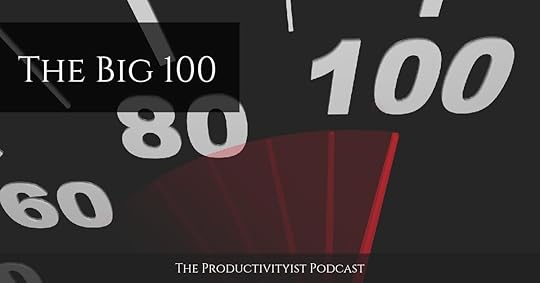
On this, the 100th episode of The Productivityist Podcast, I chat with producer John Poelstra about the evolution of the podcast since it started nearly two years ago.
We talk about the changes that we have made (and the big change that we didn’t make), the process we use to make each episode happen and why it has worked so well for us, and reveal some of our favourite episodes and thoughts about the journey we’ve had over the past 100 episodes.
Relevant Links
Roman Mars | Makes Radio
Be More Successful: The Top 10 Productivity Podcasts for 2016 | Inc.com
Greetings and Salutations (The First Episode of The Productivityist Podcast)
Unmistakable: Why Only Is Better Than Best by Srinivas Rao | Amazon
TabLinks – BrettTerpstra.com
Trello
Hacking corporate with Nick Snapp | The Productivityist Podcast: Patreon Edition
MeisterTask
Deep Work with Cal Newport | The Productivityist Podcast
Relentless Sales Success with Chris Johnson | The Productivityist Podcast
The Art of the Side Hustle with Nick Loper | The Productivityist Podcast
SPECIAL EPISODE: Laura McClellan Returns! | The Productivityist Podcast
Everything Evernote with Andrew Sinkov | The Productivityist Podcast
Everything Is A To Do with Michael Schechter & Patrick Rhone | The Productivityist Podcast
Getting Things Done with David Allen | The Productivityist Podcast
Body Talk with James Hamblin | The Productivityist Podcast
Making Better Meetings with John Poelstra | The Productivityist Podcast
The Productivityist Podcast | Patreon
Podcast Production | John Poelstra
My /Now Page | MikeVardy.com
If you enjoy The Productivityist Podcast I’d appreciate a rating and review in iTunes or your podcasting platform of choice. It helps people find the show easier and will help me make improvements on the show by seeing what you have to say. You can also fill out this survey to help me make the show better.
Want to help the show even more? Then become a patron The Productivityist Podcast through our Patreon campaign! Check out The Productivityist Podcast’s Patreon page and take a look at all of the perks – available only to Patreon supporters!
The post The Productivityist Podcast: The Big 100 appeared first on Productivityist.
June 30, 2016
Listen and Be Present: An Excerpt from “Guidelines”
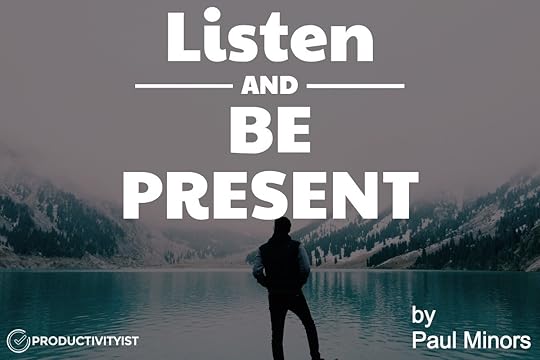
When it comes to self-improvement, books are one of the most common sources of information. As I’ve read different self-help books, many of the same ideas seem to come up again and again. For example, “focusing more on less” is an idea discussed by Greg McKeown in Essentialism and Gary Keller in The ONE Thing. Wouldn’t it be great if all of the most important ideas and advice could be summarized in one place? Well now, there is (more on that below).
Here are some of my favourite “guidelines” for living a more purposeful life, as supported by numerous best-selling authors.
Live in the here and now
It’s easy to get caught up obsessing about the future and achieving our goals. The fact that you’re reading this says something about you as a person. It says you’re someone who’s interested in self-improvement and are likely to be someone who thinks a lot about where they’re heading and what they want the future to look like. While this is a good trait to have, remember to live in the here and now. Be present and appreciate what you have at this point in your life. When you obsess about the future or dwell on the past, you fail to enjoy what’s actually important. But what is important? What is happening around you right now in the moment?
In The Obstacle is the Way, author Ryan Holiday shares why living in the moment is important and why we shouldn’t use the past or future as an excuse for giving up:
“It doesn’t matter whether this is the worst time to be alive or the best, whether you’re in a good job market or a bad one, or that the obstacle you face is intimidating or burdensome. What matters is that right now is right now.”
He goes on to highlight that the obstacles and problems we face are only made challenging by the way we perceive them. It doesn’t matter what’s happened in the past or what the obstacle could mean for the future. These thoughts shouldn’t influence what’s important—which is making the right decision based on where you are right now.
“The implications of our obstacle are theoretical—they exist in the past and the future. We live in the moment. And the more we embrace that, the easier the obstacle will be to face and move.”
In Essentialism, Greg McKeown discusses how being present helps you prioritize and identify the most important tasks to work on right now:
“When faced with so many tasks and obligations that you can’t figure out which to tackle, stop. Take a deep breath. Get present in the moment and ask yourself what is most important this very second—not what’s most important tomorrow or even an hour from now.”
Now this doesn’t mean you should forget about the future. Of course, what you do today will have an impact on what you achieve a week, month or year from now. But when you feel overwhelmed with things to do, let this all drop away. Focus instead on what’s most important right now. Use the here and now as a filter as a way to identify your most important tasks.
Living in the here and now doesn’t just mean living in the present moment. It also means being more aware of your current environment. In Manage Your Day to Day, Scott Belsky points out how easy it is to distract yourself using technology and challenges the reader to instead focus on being present during the day:
“These days, when a meeting, movie or lecture comes to an end we immediately check in to social channels to see what’s going on. Take a break from checking your smartphone during transitional moments. Open yourself up to opportunity and serendipity. Take the time to see how you’re feeling. Be in the present and chat to someone you don’t know. It’s amazing what secrets you can unlock in your mind and around you.”
As we come to the end of this book, I’d like to leave you with this idea from Hal Elrod, author of The Miracle Morning:
“Give yourself the gift of investing just 30 days to make significant improvements in your life, one day at a time. No matter what your past has been, you can change your future, by changing the present.”
This quote does a great job of communicating something very important; it doesn’t matter what’s happened in the past. However, if you want to change the future, you need to focus on the present moment and how you’re living your life right now.
Above all else, remember that if you forget to live in the present, you risk missing all the amazing moments that are going on around you right now. Moments you’ll never get back. You may find you get to the future and it’s not what you expected. You may find yourself looking back regretting not being more present. You’ll be thinking that you won’t make the same mistake again without even realizing that by dwelling on the past you’re missing another beautiful moment. Remember to be present every day. Don’t obsess about the future, stop dwelling on the past and enjoy the here and now.
One of the ways you can be more present is to be a more active listener, which is why I love this next guideline. When talking to others, it’s incredibly easy to let your mind wander as you watch the other person’s lips move without absorbing what has been said. Next time you get into a deep conversation, instead of thinking about what you will say next, listen to their words. Try to appreciate their point of view.
The Importance of Listening
Hearing someone talk and actually listening to the words they’re saying are two completely different things. It’s easy to nod along, hear what’s being said and give the impression that you’re listening. To listen means to understand other people’s perspectives and take action. Even if that action is doing nothing, to understand and have respect for other people’s point of view is a skill that more of us need to master.
In his book, How to Win Friends and Influence People, author Dale Carnegie talks about listening as one of the fundamental principles to get people to like you:
“If you aspire to be a good conversationalist, be an attentive listener. To be interesting, be interested. Ask questions that other persons will enjoy answering. Encourage them to talk about themselves and their accomplishments.”
This doesn’t mean you approach someone with a false sense of respect. If you listen while continuing to formulate your own ideas in your head instead of actually responding to the other persons view point, you’re doing things wrong. You actually have to care about the other person and have an appreciation for what they have to say.
Listening and understanding other viewpoints will improve your ability to win that person over and eventually convince them to your way of thinking (assuming you don’t change your opinion after hearing their words). Marcus Aurelius further supports the importance of listening and understanding other people in his book, Meditations:
“Practice really hearing what people say. Do your best to get inside their minds.”
I like this idea of getting inside the other person’s mind. This means really standing in the other person’s shoes, trying to imagine the world through their eyes and really thinking about how they feel.
Fried and Heinmeier, the authors of Rework, discuss the importance of listening in a business context when it comes to dealing with unhappy employees and customers:
“When people complain, let things simmer for a while. Let them know you’re listening. Show them you’re aware of what they’re saying. Let them know you understand their discontent.”
When you show that you care by listening with intent, you’ll be amazed at the response from others. Often, we have to fight to be heard. We go into an argument with the preconceived idea that the other person isn’t going to listen. We think we’re going to have to build a case to win the other person over. But when you’re met with someone who listens and respects your opinion, it almost catches us out by surprise. In response, our respect for that other person goes up. Even if we eventually come around to their way of thinking, the fact that they cared enough to listen, commands great respect.
What is Guidelines?
Reading more is something most people have on their to-do list, but is something that often gets pushed to the side due to a lack of time or other tasks taking priority. To help with this, I’ve created a new ebook, called Guidelines, that summarizes the main lessons learned from 30 best-selling self-help books.
Guidelines lists 27 rules (or guidelines) that help you improve your productivity, become a better leader, do better in business, improve your health and succeed in life. The book digests the best points from over 30 best-selling books like The 4-Hour Work Week, The Miracle Morning and The Obstacle is the Way into 27 specific and actionable guidelines.
Guidelines isn’t a replacement for these books (which everyone should read), but it is a quick way to take action on the most beneficial pieces of advice.
If you want to pick up a copy of Guidelines, it’s available as a 68-page ebook and 97-minute audio book. The launch sale runs until 10pm EDT Friday the 1st of July, so pick up a copy today.
The post Listen and Be Present: An Excerpt from “Guidelines” appeared first on Productivityist.
June 28, 2016
A Meeting With Me
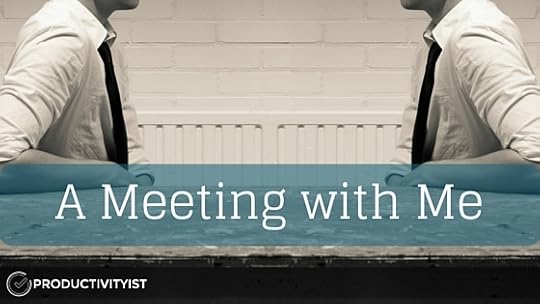
I used to detest meetings.
I considered them a massive waste of time, mainly because they often revolved around taking as much time as possible. There were even some coworkers who loved the time that meetings took up in their day. Maybe it was to look important. Maybe it was because meetings were a form of escape from the day-to-day for them. Maybe it was because they enjoyed hearing what others were doing.
But I did not enjoy meetings at all. In every meeting I could feel the call from my daily task list reminding me of what I could be doing instead. I also felt anxious because there would be even more landing my plate before said meetings were over. The association that I had with meetings was not good – and they weren’t productive as a result.
After leaving the jobs that involved many meetings, I found myself having no meetings for a while. It was awesome. But there were still times when I felt that pull of the task list anyway, despite the fact that I had no meetings to be part of that kept me from the list. It was then that I came to the realization that meetings weren’t necessarily the thing that kept me from my tasks.
My problem with meetings was, more often than not, me.
So I decided to try to solve both of my problems at the same time. A kind of multi-tasking, if you will.
I started to have meetings with myself.
At first, those meetings were where I would do my GTD Weekly Review. But I soon realized that I didn’t cover everything needed during that timeframe, so I separated those time chunks out. I decided that a 30 minute meeting with myself every week would work wonders for me. I’d create an agenda and run my meeting with that agenda in mind. I’d take notes and assemble meetings minutes from those notes. I didn’t do anything else formally. I simply had an agenda and created minutes afterward.
And you know what?
It boosted my overall productivity.
I became more aware of what needed to be done between each meeting. I planned better. I got better at distributing my time between being the guy running the business and the guy working the business.
Heck, everything got better.
So I started to have other meetings. I began to have weekly meetings with my wife to discuss matters of finance, food, and family so that we could dedicate our regular date nights to leisure time rather than household business time. I even began to have work meetings again. With other people. For my own company.
This is a far cry from how I approached meetings just a few years ago.
I’ve definitely become more productive and bolstered my relationship with meetings at the same time by having meetings with me. By catering the meetings to work for someone who abhorred them (me) I’ve turned a largely negative experience into something decidedly positive.
It showed in the results…and it still does.
Want to learn more about what I did to improve my meetings and make them matter more? Then you’ll want to check out Meeting Makeover. I teamed up with meeting facilitation expert John Poelstra to build this 4 module audio program, complete with worksheets, a companion guide, transcripts and more. Meeting Makeover is ideal for small teams but can be scaled up to work with larger teams once you’ve invested time and focus on the frameworks we deliver in the program. Considering it’s estimated that $37 billion dollars per year is wasted in poor meetings, the price we’re charging – just $39 – is a steal. Don’t waste any more time…or money. Click here to get Meeting Makeover today!
The post A Meeting With Me appeared first on Productivityist.
June 27, 2016
The Productivityist Podcast: Being Truly Productive with Michael Dolan
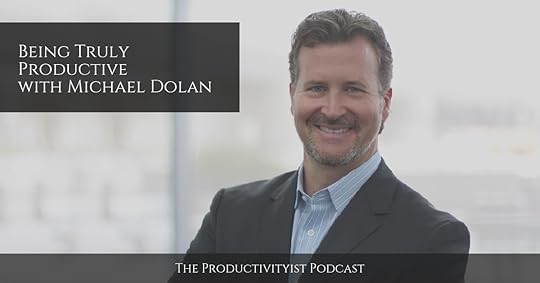
On this episode of the podcast, I speak with Michael Dolan. Michael is an executive coach who helps leaders get out of their own way by enabling them to develop and maintain higher levels of productivity, self-awareness and effectiveness so that they can create a bigger impact and experience greater satisfaction in their work and life.
Based on his 15-years of management experience, Michael understands the intense personal and organizational demands that successful executives must meet on a daily basis. We talk about his journey as an executive coach, his views on David Allen’s Getting Things Done (GTD) methodology, how he uses the Enneagram in his work, and more.
Relevant Links
Truly Productive Leadership
What is the Enneagram?
Getting Things Done by David Allen | Amazon
Headspace
Muse: The Brain Sensing Headband | Amazon
The Productivityist Podcast 73: Cal Newport
The Productivityist Podcast 66: A Doer Who Likes To Be with Michael Townsend Williams
Truly Productive | Facebook
Michael Dolan, PCC (@MichaelPDolan) | Twitter
If you enjoy The Productivityist Podcast I’d appreciate a rating and review in iTunes or your podcasting platform of choice. It helps people find the show easier and will help me make improvements on the show by seeing what you have to say.
Want to help the show even more? Then become a patron The Productivityist Podcast through our Patreon campaign! Check out The Productivityist Podcast’s Patreon page and take a look at all of the perks – available only to Patreon supporters!
The post The Productivityist Podcast: Being Truly Productive with Michael Dolan appeared first on Productivityist.
June 23, 2016
Hacking Corporate: How to Create the Work Environment You Want
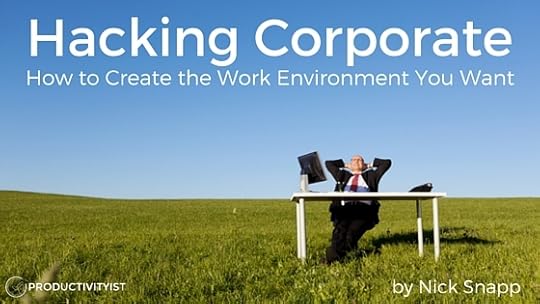
The following is a guest post by Nick Snapp (who’s also been a guest on The Productivityist Podcast. Nick is an Engineer-turned-Productivity Strategist and the host of The Make it Snappy Productivity Show podcast. He’s also the founder of Snapp Forward, an innovative coaching program designed to help busy, high-achieving parents eliminate overwhelm, improve focus and achieve superior productivity.
Working a lot of hours? You’re not alone. According to the Bureau of Labor Statistics, 21% of the North American workforce clocks at least 49 hours per week, and 11% work more than 59 hours per week.
You think there’s no alternative to all of those hours in the office. So you play the game.
Sadly, all these games and distractions create a looming tension between your company’s expectations and your personal boundaries (especially if you’re wired with the spirit of an entrepreneur). You could blame your company for the tension, but that would be unproductive. After all, you created it.
Fortunately, since you’re the creator you have the ability transform the tension into something that serves both you and your company. It’s called “hacking corporate,” and you can do it in less than 40-hours per workweek.
Here are five ways to start hacking corporate, create the freedom you desire, and still perform like a rock star at your corporate gig:
1. Shift Your Focus: It’s Not All About You
Effective corporate hackers figure out how to add the highest value to the company first, then (and only then), how to do it with freedom. In your employer’s eyes, the value you provide is limited to your personal performance. Yet, what is critically neglected in corporate is how an office environment can either foster or destroy the amount of value an employee contributes.
Which environment creates more value: one where employees have autonomy to pursue a challenging, purpose-driven career, or one where he or she is constrained to a cubicle, micro-managed, and challenged with unnecessary meetings?
As a corporate hacker, it’s your job to educate those around you of the value you’re able to create when you have the freedom to come and go as you please. But to get to this point, you have to start with the needs of your employer.
2. Prove Yourself
Corporate hacking is a marathon, not a sprint. If you’re new to the company or you’re in a new position, congratulations…now prove yourself.
Prove yourself by listening to your colleagues. You need to understand their pain points, get curious, and ask questions. Talk to your Senior Directors, your Vice Presidents, and the CEO. Strive to understand what results add value to your company. Learn which activities or projects are perceived as unnecessary overhead to the higher-ups.
These conversations will serve as your roadmap. It’s amazing how much you can glean from a 15-minute conversation with an executive who has the ability to boost your career.
3. Plant Seeds and Experiment
Once you know which activities add value, focus on what you need to do each day to achieve exceptional results in these areas. Minutia will undoubtedly begin to surface: last-minute meetings, email clutter, water cooler conversations and cubicle invasions.
Prepare yourself for these events by building an effective personal infrastructure for navigating corporate boundaries. This requires experimenting with unorthodox office tactics in such a way that you’re constantly maintaining focus on the value you provide the company when you eliminate corporate distractions.
In practice, this may mean you work from a location other than your cubicle. Try working in an empty office or conference room, or the downstairs lobby. Sure your supervisor may not approve, but that’s how you collect data for your experiment.
If you get called out, great! Don’t make excuses—own it. This is your opportunity to show how your actions have created value. If your boss doesn’t get it and objects, consider this the start of your negotiation. Figure out each of the following:
What are his or her concerns?
How can you address the concerns and still create the freedom you desire?
Does he or she understand the value in what you’re working on?
Does he or she want results faster? Why or why not?
You may not get what you want right away, but you’ve planted a seed, and that’s the point.
Now create another experiment, then another, and another. Ask for forgiveness, not permission. Permission-seekers never get the chance to experiment. Remember, your experiments are rooted in the question, “How can I add maximum value to my company?”
Don’t give up. Consistently plant seeds, exceed performance expectations and over time, your freedom will grow.
4. Set Boundaries Early
While working from home one afternoon, my Supervisor called to notify me of his retirement. He had been receiving a free education from me on corporate hacking for over three years. This was going to be an adjustment; his replacement had a solid reputation for micro-management.
I immediately set up a discussion with my new boss the very next morning (coming in on my day off – yes, setting boundaries is that important) to gain a clear understanding of his objectives for our department.
I communicated my excitement about his vision and described the environment I had already created to serve him optimally to make the best use of time: away from my desk.
He agreed. I left the office after our meeting to go add value, while the remainder of his direct reports endured the challenges of cubicle life.
There’s only one way to set boundaries: fast and hard.
5. Lead By Example
Corporate hackers are unconventional. They do things differently by:
keeping their email off and only check it in batches,
cutting off cubicle interruptions like a ninja while making invaders feel good about themselves,
not attending meetings unless they know exactly why they’re there, and if they do, they leave when they’re no longer needed, and
spending less than 50% of their time at their desk.
If you decide to embrace the corporate hacking lifestyle you’ll likely be criticized. Never be defensive; own it and maintain consistency. Are you adding value to the company? If yes, then what are you worried about?
Over time, insults will turn to praise. Then praise will transform to emulation, which is the best form of a compliment you’ll ever receive.
The post Hacking Corporate: How to Create the Work Environment You Want appeared first on Productivityist.
June 21, 2016
Why I Write Well After 9 PM
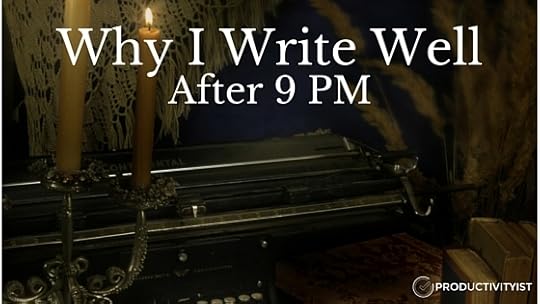
I’m writing this at 9 pm PDT, which is usually when my creative juices really kick in and I start to write well.
I’m not sure why this is. I suspect it’s because both of my kids are in bed. The quiet allows me to focus, as I know the next time I’ll see the kids is in the morning.
For a time, I tried to write in the early hours of the morning. With this approach, I had to make sure I finished my work before the kids woke up. The problem is that when I did this, I always had two questions in the back of my mind:
Why in the world am I up this early?
What if the kids wake up?
The first question was there because I have always thrived in the later hours of the day. To try to “rewire” myself seemed counterproductive, but since I’d read about how smart it was to do get up early, I worked hard at it. I now realize that because I didn’t like to do it, my effort was less than 100%. But I still kept at it, despite knowing that I wasn’t working at optimum levels.
The second question arose because it was a legitimate one. What if the kids woke up? I mean, being up at 5 am to write was all well and good but if my son woke up at 6 am while I was in the state of writing flow I was faced with two choices: send him back to bed or let him stay up. More often than not, the latter choice was wiser because the effort of putting him back to bed took far too long.
I hated facing this question in the morning because it had two possible answers.
But at night it only had one. There was no other option. If Colton woke up at ten, eleven, or midnight, I sent him back to bed. Even at 2 am – I have stayed up that late in the past – he was briskly sent back to his room. Decision fatigue wasn’t a factor; there was no decision to make. Back to bed he went.
From this moment until I go to bed (likely around 1 am tonight) I won’t be faced with any disruptions or distractions that can be dealt with swiftly and simply. I’ll have the quiet I need to do the writing I want to do. And tomorrow morning when I wake up at 8 a.m. I’ll tackle the low energy tasks that need my attention because I’ll be able to give them that level of attention. I’m going to get 4 hours of solid creative work in tonight…which is more than a lot of people I know get in a week.
Are you a night owl like me? Ready to be more productive? I created something to help.
The post Why I Write Well After 9 PM appeared first on Productivityist.
June 20, 2016
The Productivityist Podcast: Distractions & Disruptions with Dave Nevogt
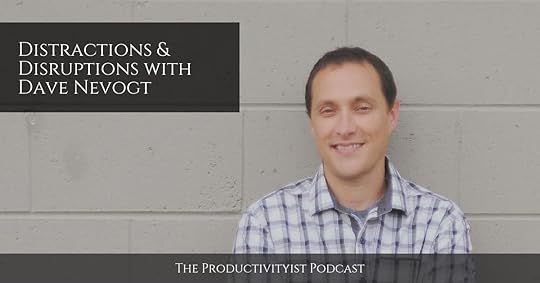
On this episode I speak with Dave Nevogt. Dave is the co-founder of Hubstaff and we chat about what it’s like to pivot from one entrepreneurial venture to another and how he is especially adept at eliminating distractions and dealing with disruptions.
Priority plays a role in how Dave handles his tasks and he shares how he keeps himself moving on the right path along the way. We also dive into what he does to help infuse some of his own strategic way of dealing with distractions and disruptions within Hubstaff. Dave also shares his thoughts on striking a balance between quantitative and qualitative productivity.
Relevant Links
DaveNevogt.com
Hubstaff
The Definitive Guide to Building a Remote Team | Hubstaff
Everything we’ve learned to grow our time tracking startup | Hubstaff
Hubstaff (@hubstaff) | Twitter
Dave Nevogt (@dnevogt) | Twitter
If you enjoy The Productivityist Podcast I’d appreciate a rating and review in iTunes or your podcasting platform of choice. It helps people find the show easier and will help me make improvements on the show by seeing what you have to say.
Want to help the show even more? Then become a patron The Productivityist Podcast through our Patreon campaign! Check out The Productivityist Podcast’s Patreon page and take a look at all of the perks – available only to Patreon supporters!
The post The Productivityist Podcast: Distractions & Disruptions with Dave Nevogt appeared first on Productivityist.



